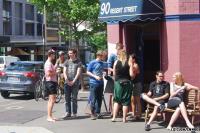Squatting in Sydney is now not just behind padlocked doors and busted windows: Groups are bringing the movement into the mainstream community
By Liz Cush 14 April, 2011
Faced with ever-increasing rents and the terrifying notion of moving to the outer suburbs, many homeless people are still choosing to squat around inner city fringes.
The movement is far from its peak of decades ago when boarded-up squats were common along the now gentrified Glebe Point Road. What were once squats around Victoria Street, Potts Point, are now backpacker hostels.
Something else has surfaced -- these “tenants” are becoming more visible and initiating inner city spaces as communal areas. Strands of anarchism and leftist politics still form their core.
The “People’s Castle” in Redfern gave the movement increased attention, much like its well publicized predecessor, “Squat Space.”
In inner west Rozelle, owner and council have sanctioned a squatter-initiated space.
An art exhibition is set to launch in Enmore documenting squatting in Sydney.
More and more, these space invaders are claiming disused houses as communal areas and opening them to the arts.
A decade ago: The inspiration of Squat Space
In 2000, youth worker Fuji squatted in a disbanded building on Broadway. His squat mates included activist lawyers and performers, and during the city’s Olympic year regular parties, art exhibitions, political film nights and a free café were open to all.
The movement inspired many squatters to open spaces as autonomous social centers. They squatted not just as a means to avoid rent, but to take over city spaces as non-commercial venues and meeting places.
Fuji has lived in seven more squatted houses since then. “It's about owning my own time and myself and not having to answer to anyone else or give my time to an employer or landlord,” Fuji says.
"The People’s Castle"
Squatters outside the "People's Castle" who set up a free community space before being evicted by City of Sydney Council
Last year, a group of squatters was evicted from several different unoccupied houses in the inner west: Erskenville, Hurlstone Park, Enmore and Redfern were all been called home.
Squatters are, in many ways, irrepressible. They later resurfaced in a pink, two-story house in Redfern, dubbed “The People’s Castle.”
The squatters set up a “free shop” in the downstairs lounge room of their home and invited people to come in for free lunch, tea and coffee and to hang out.
“It's good to see how easily you can live without money at all,” says Leo, one of the squatters. “You can move into a dusty house with no furniture and no electricity, but you have your crew -- your squatter family around you -- all sleeping on the floor.”
They gained statewide attention when they were evicted from the house by the often liberal-minded City of Sydney Council.
Turning a slum into a home
Many squatters make sure to set up each new home with solar-powered electricity, running water and white goods.
One of the group, Ash Faulkingham, a sustainable energy student, has spent thousands of dollars on solar panels. He says it's easy to find an empty building to squat -- the challenge is not getting thrown out.
“There are lots of empty buildings and though they are in various states of disrepair, they could easily be fixed up, were it not for the fact that people will inevitably come and hassle you,” he says.
Scum versus Scum
Huck, who has squatted for four years, has organized an exhibition documenting squatters in Sydney.
“The abundance of empty buildings being left to rot is the real crime,” says Huck Spin, who has squatted for four years.
He is organizing an art exhibition this month -- The Housing Crisis Showdown: Scum vs. Scum -- at an artist-run gallery in Enmore.
“Home owners, real estate agents and higher class people think that people like us -- squatters and activists -- are scum, but we think the same thing back,” Huck says.
He says his exhibition is about, “Ways we can work towards stopping high rents and being more resourceful and working together."
The Housing Crisis Showdown: Scum versus Scum at Plump Gallery, 240 Enmore Road, Enmore, April 19-29, weekdays 10 a.m.-6 p.m., weekends 11 a.m.-7 p.m.
Anyplace Projects
A group of squatters, past and present, has initiated an association to develop and use un-utilized space, providing a home for the community and the arts. It has been sanctioned by the building's owner and the local government, Leichhardt Council.
The project has dual aims: to make space available to those who need it and to provide property owners with tenants to discourage trespass, vandalism and a range of other issues common to abandoned buildings.
They are organizing 30-day caretaker leases between squatters and property owners.
Local punk duo "Politikal Graphitti" perform at the Anyplace PSH Gallery.
“It provides an inner city residence for artists to create works who would not otherwise be able to afford rent,” says Liam O’Donoghue, one of the cooperative.
Their events include independent film nights on Wednesdays, monthly music gigs with live graffiti, art exhibition openings on the last Friday of every month – and non-stop residencies.
Anyplace Projects, 118 Terry St., Rozelle, www.anyplaceprojects.com




